[size=24.57px]Acknowledgment [/size]
Thank you Eric at Effect Audio for making the HeadFi tour of the Arthur and Excalibur pairing possible and letting me join in. I was provided the Arthur/Excalibur on loan in exchange for my honest opinion.
This review was originally published on my blog.


Inside is a magnetic latching case with a ribbon release. Accessories included a heavy duty case with cut foam compartments for the IEMs, the cable and the cleaning tool; two soft velvet bags (one large and one small), a polishing cloth, a cleaning tool, and a quick start guide that tells you how to maintain your new flagship headphones and how not to blow up your ears. The Arthur is very sensitive, so I would heed the listening volume advice.
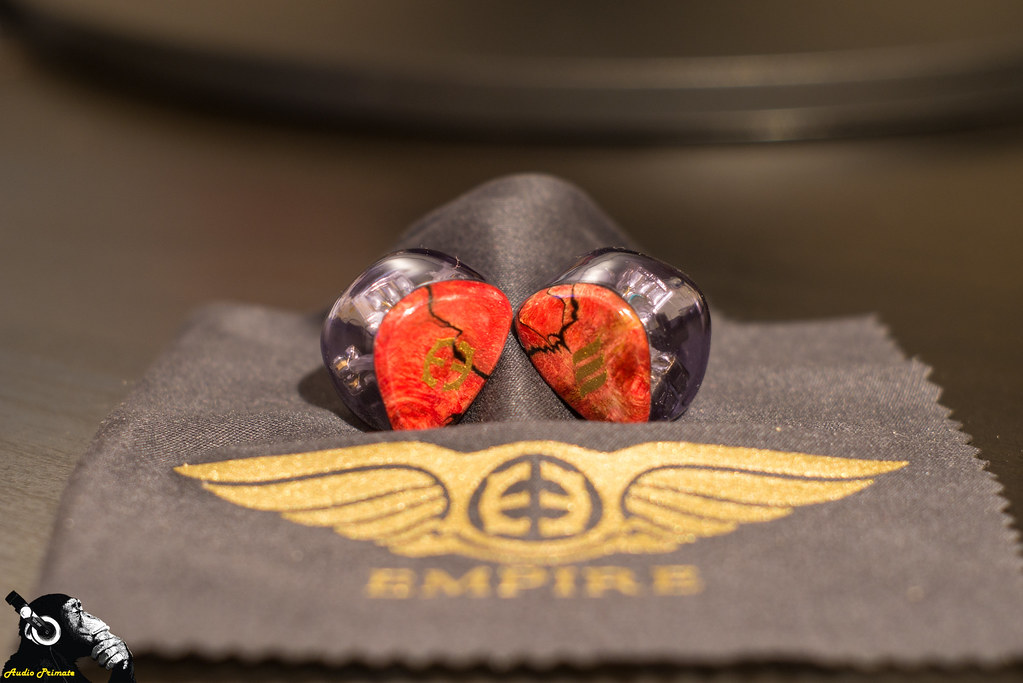
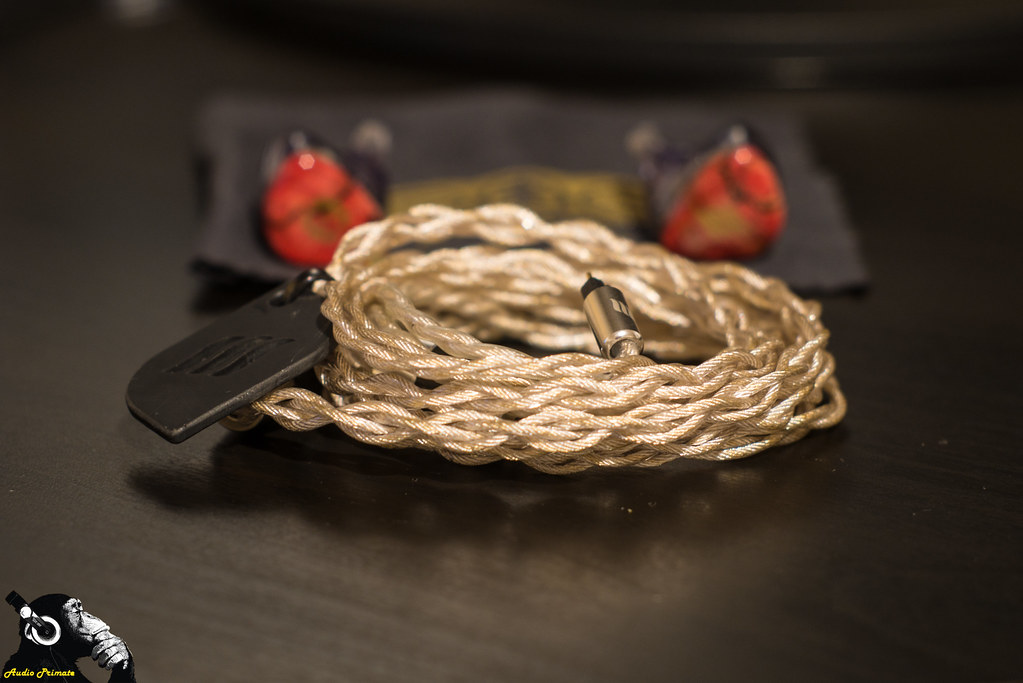
The Arthur is beautiful to look at. I really like the slight lavender hue to the transparent shell, and the red jade like finish of the faceplate is equally lovely. When combined with the Excalibur cable the setup is truly a show-stopper on looks. So much better than a knock-out punch. I believe more options are available for finish, as Empire Ears is the maker of the IEM portion and they do lots of customisation.

When it comes to fit though, I had troubles.

The demo unit only came with three sizes of Spinfits and none of them held firmly enough with the bulk of the Arthur’s shell. It isn’t heavy, but it is distributed enough to require some grippy tips to stay in. Usually when I need grippy tips, my favourites are the Spinfit CP220 biflange tips. I tried these and could get a secure fit and seal, but I had to jam them in so deep that it wasn’t terribly comfortable. I then moved on to my Comply T400 Isolates. I tend to prefer silicone tips for most IEMs as they are more neutral than foam tips. Foam tips generally soften treble and boost midbass, in my experience. There was no way to avoid using foam if I wanted comfort and secure fit and seal with the Arthur. However, my go to Isolate series, and the white foamies that came with the Unique Melody Miracle v2 have too wide bores for the nozzle on the Arthur. This is a significant oversight, in my opinion, as the Comply Isolates are some of the most popular aftermarket tips. They are the tips that are included with most IEMs that include Comply foam tips (generally 300-500 series). Luckily, I’ve got a lot of tips on hand, and my RHA gear came with Comply TSX-200 tips that have a little bit smaller bore. For this review I will use the TSX-200 throughout. Because the 400 series tends to be the standard size for high end universal IEMs, it might be a good idea for the nozzle size to be updated, or to include a few pairs of T200 Comply foam tips. Most folks will be reaching for T300 to T500 series tips for their high end universals. The sheer size of these can be seen in the image below.
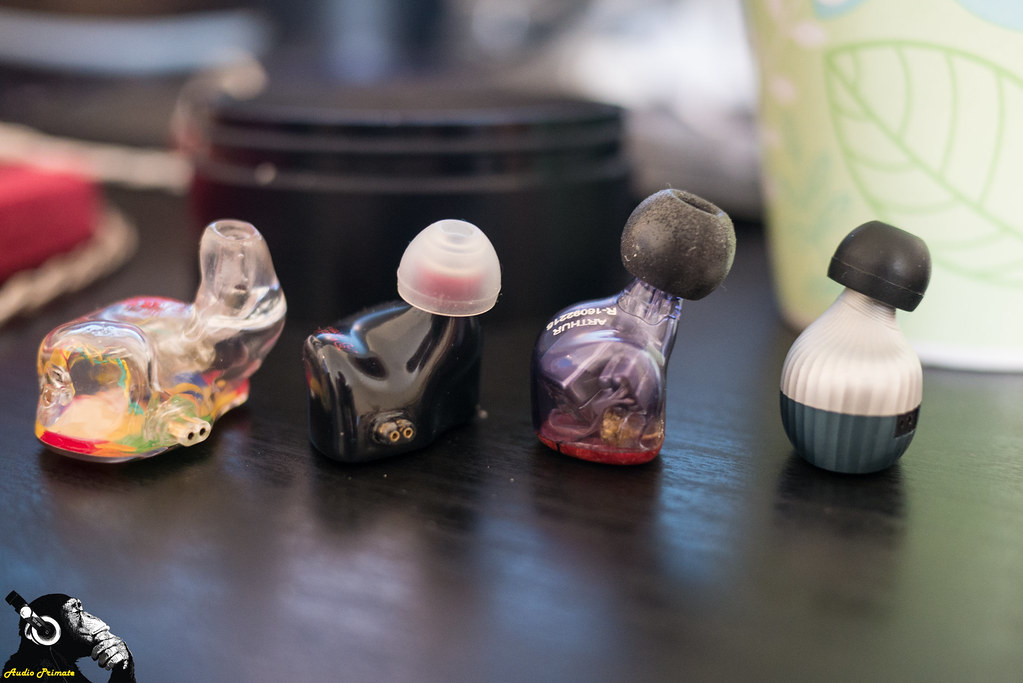
For folks buying at this end of the price spectrum though, the best bet is likely going for the custom version of the Arthur. Customs will have none of the fit issues or tip rolling trials that I ran across. No need to toss Arthur in the lake.

On looks, both the Ares II+ and the Excalibur are stunning, but the Excalibur takes it to a whole new level. The micro-coiling of the Litz wire in the delicate sheathing, the easy twirling of the cable has a visual and tactile evocativeness akin to a diamond dust encrusted silver chain. It positively shimmers, I feel like a hip-hop superstar rocking bling 20 times my paygrade. The cable is a piece of art. It isn’t just a headphone cable, it is jewelry, and a statement piece at that. The warm copper and chunkier presentation of the Ares II+ are not nearly as arresting to the senses—visual or tactile.
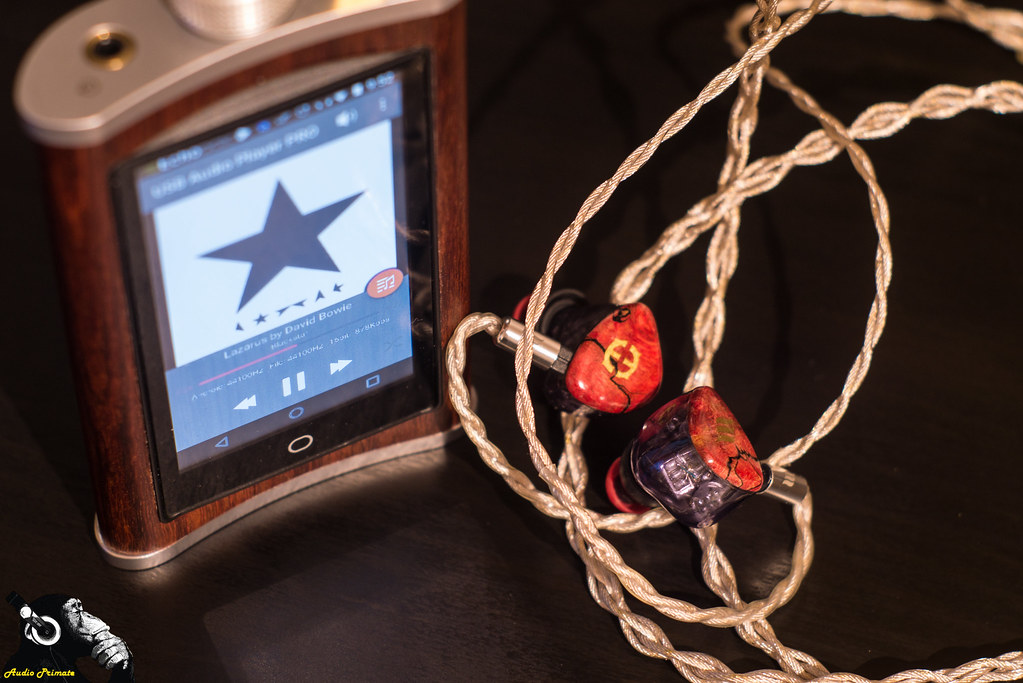
For sound, differences are very subtle. I listened in a volume matched comparison, but without having duplicate IEMs for switching the time between switches, due to unattaching and re-attaching cables, makes it so I can’t guarantee the veracity of my hearing. What I hear is just as likely to be bias due to the more refined looks of the Excalibur as real difference—we hear with all our senses, and our eyes can bias us. With that huuuuuuge caveat, this is what I think I hear: the Excalibur is a bit more open, while also having slightly more immediate mids. Both have open sounds, but the Excalibur may be slightly more so. On Where is My Mind the female backing vocal soars a bit higher. The Excalibur sounds a tiny bit more precise, while the Ares II+ is a bit smoother. Both are excellent. It took me several back and forth switches and several tracks to really feel out the differences between the cables. Tracks I used: Pixies – Where is My Mind, Fleetwood Mac – Dreams, Eagles – Hotel California, Rebecca Pidgeon – Spanish Harlem.

The highest praise I can give a headphone, is that when it plays well-recorded music, it sounds like a miniature version of being there. The best headphones sound like live music when fed the best music, not like a recording of music. The Arthurs have this kind of realistic representation. I turned these onto Chesky’s 30th Anniversary set and just didn’t want to take them out of my ears for four hours—that’s a lot of jazz. I’m not even that into jazz. They were the most impressive headphone I listened to at Headroom, and I listened to HiFiMan’s Shangri-La—I got busy and missed my HE-1 session on accident. Doh!

The sound is light, breathy, full of air—to match a full-size planar magnetic. I compared these against the HiFiMAN HE-1000 V2 at Headroom and found that I actually preferred these. They punched even with the HE-1000 V2, which were my previous favourite current production headphone. They matched them on soundstage and had a midrange that was a bit more fulfilling for me. The meet setting noisy room caveat does apply for the HE-1000 V2 comparison. I didn’t do a Noble Kaiser Encore comparison due to limited time and so much to see—should have done it.
Listening to Carlos Heredia – Chachipen-Bulerias. The Arthur’s dimensionality and resolution is stunning. The acoustic guitar, percussive claps and singing are like being there. Tonally, the Miracle v2 is a pretty good match on this track. The whole sound is feels louder, which may be due to a boost in the mids on the Miracle v2 or recession in the mids on the Arthur. The soundstage height is impressive on the v2, but the Arthur wins easily on depth and width. Both are truly excellent headphones that have a very natural timbre.
On Led Zeppelin – D’yer Mak’er bass and mids are smoother and bigger on the Melody v2. As observed on previous tracks the sound is more forward with less stage depth and width at the same SPL. Drums have a bit more hollow sound on the Melody v2. The Arthur has a more distant presentation, with less relative weight, increasing the volume 3 clicks, which is probably a little over a decibel, brings the mids to the same weight as the Miracle v2. Unsurprisingly, this also makes the Arthur win even more on dynamics and stage. I think people will listen to the Arthur a little louder than other headphones, but when they do, boy does it step up. My normal listening level is about 78dB. I think I’d listen to the Arthur at 80dB to bring those mids forward a little bit.
The Arthur soundstage is huge on Amber Rubarth – Tundra. Hot damn.

On Yosi Horikawa – Bubbles (thanks to Warren P. Chi for the recommendation), the sound is much more delicate and nuanced on the Arthur. The Melody v2 is in your face with nuances not quite having the same delicate delineation. The Arthur is more refined. The Melody v2 is thicker sounding, but thick only in relative terms to the Arthur. The Melody v2 is not a thick sounding headphone.
Victor: On sound quality, the Arthur. It is more refined has a huge soundstage and a natural timbre and resolution. The Miracle V2 does firmly show what kind of value can be had for around $1000.
Height advantage goes to the UERR for the female backing vocal on Where is My Mind. However, the tone is more natural and musical sounding on the Arthur. The UERR doesn’t make me think of live music, it lacks the lush sonic tones and richer pallet. Those mids are a little recessed on the Arthur, though, so I do believe I’m not the only one hitting volume a little. All the mids details like the little male vocals—the quiet where is my mind questioning in the back drop, are still there but quieter. I’d guess the vocal range of mids is one or two dB down from neutral. Over time your ears adjust a little bit, but the drop is definitely there.
On Strawberries by Why? Yoni Wolf’s vocals are silky smooth and emotive. The bass has great kick and the chimes and piano absolutely sparkle and splay on the Arthur. The instrument separation and bass character are phenomenal. There is definitely less width to the stage on the UERR. Resolution is good on both, but hand claps have a little bit of a thin sound to them with the UERR, like the decay has been truncated a bit. The sound is a bit thicker and firmer on the Arthur.
On D’yer Mak’er (Led Zeppelin) the sound stage is much more congested sounding on the UERR. There is less separation between instruments and a more immediate sound. It sounds louder than the Arthur, but the soundstage difference is still apparent. This louder character has me questioning whether my volume matching was perfect, but I’m not sure I can completely eliminate the potential measurement error.
Victor: Conclusions are similar to the Miracle V2. The sound quality edge goes to Arthur, but the UERR are an unquestionable value.
On Too Long, there is some delicate high trill electronic effects and subtle static. The Arthur does a better job resolving these special effects. Similarly, after the 7 minute mark in the song—long indeed—there is some grooving bass. The Kaiser Encore has longer decay on the bass with more power. The Arthur is more compact in its bass notes. Sound preference on this bass expression will vary from person to person, but I imagine that more folks will prefer the Encores expression here. Arthur was airier for the whole track.
On Why – Strawberries the Noble has that same strong bass expression we heard on Too Long with longer decay and more presence than the Arthur. The Kaiser Encore also has smoother mids that are more forward. As noted in the UERR and Miracle V2 comparisons, the Arthur has some recession in the mids. However, treble-centric instruments like violins sound better on the Arthur. Violins are smoother and more enjoyable on this track with the Arthur. This track has some prickly violin, and that is still there on both, but the Arthur is a bit nicer.
Bubbles is a fantastic track. The Encore presents the sound in a more lush manner, whilst the Arthur is more precise, neither goes overboard on either side. The Encore is never woolly, and the Arthur is never surgical and sterile, both have wonderful musicality. The Arthur gets the resolution edge here, but the Encore has the edge on soul.
I mentioned earlier that I listened for 4 hours straight to jazz with the Arthur, which is something I just don’t do. Silly Samba by Clark Terry is a standout track on a standout 30thAnniversary Compilation from Chesky. The Arthur excels technically on this track with more air and faster bass. However, the Encore sounds a bit more organic. It has lusher horns, whilst the Arthur sounds a bit drier.
The Encore’s extra weight in the mids gives extra emotional force to tracks. I find much of the emotion in tracks lies in the mids, so the Encore’s lush brushstrokes really paint a beautiful picture.
Like on other songs, Encore is more aggressive and forceful on Rage Against the Machine – Take the Power Back. Drums have more kick and push more air. The mids have fuller body and lusher dynamics. The Arthur is precise with calculated crunchy guitars and sharp focus. Because of the recession in Arthur’s mids, the mids on the Encore sound clearer.
Verdict: This is very tight. The Arthur has greater technical capabilities (bigger soundstage, better detail resolution), but it costs almost double what the Encore does. It has a bigger soundstage and better resolution. However, it lacks the emotional weight that the Encore carries and the raw power in the lows and low mids. The Arthur can rock, but not like the Encore rocks. On tracks that require complex spatial resolution and precise instrumentation, the Arthur wins, but this isn’t a huge amount of my more rock-oriented library. Signature wise, I think I narrowly prefer the Encore, but it wouldn’t be on all tracks and I miss the soundstage and perfect clarity and resolution of the Arthur already. Winner, by a hair: Noble Kaiser Encore for better value and a sound signature that fits more of my music.
Whether the Arthur is your ideal headphone likely depends more on the type of music you listen to. If you are into Jazz and Classical, I think the Arthur will be nearly perfect. If you listen to more rock, like myself, you may find that you want a bit more emotional investment in the mids and lusher fuller bass character like that found on the Noble Kaiser Encore. I haven’t heard better for soundstage in any IEM than what the Arthur accomplishes. It is truly astounding.
][/color])
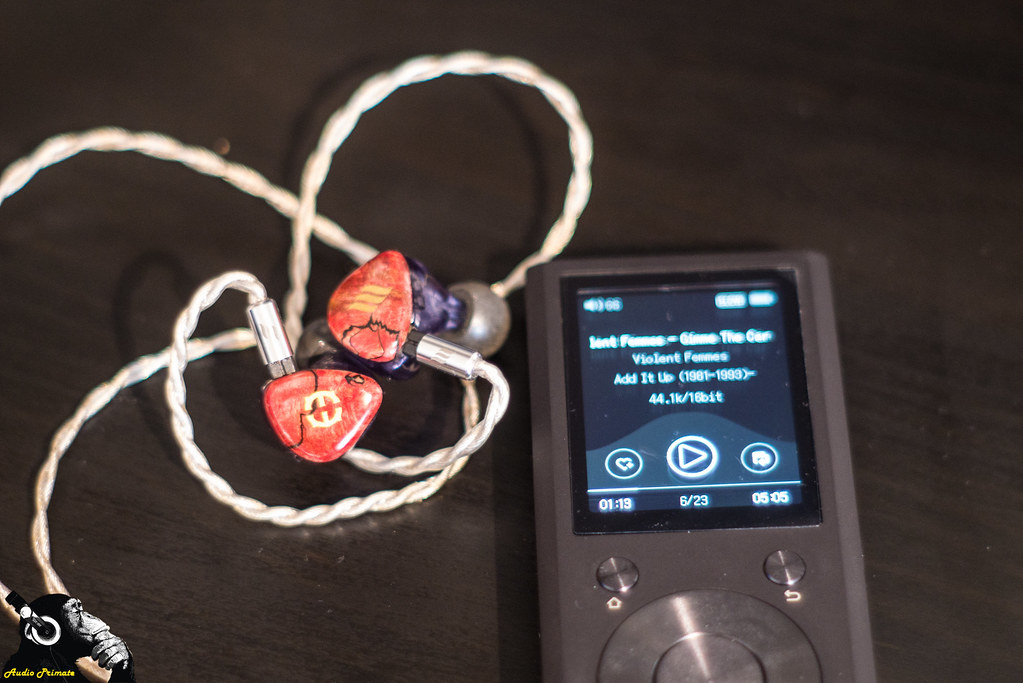
Thank you Eric at Effect Audio for making the HeadFi tour of the Arthur and Excalibur pairing possible and letting me join in. I was provided the Arthur/Excalibur on loan in exchange for my honest opinion.
This review was originally published on my blog.
Introduction
I’ve had the recent privilege of getting extended listening with some truly excellent IEMs. In my listening there seems to be an almost continuous forward progression toward infinite expenditures. The Effect Audio Arthur and its bespoke Excalibur cable follow this trajectory. The Arthur and Excalibur combination is the result of research and development in partnership between two companies: Empire Ears and Effect Audio. Jack Vang and the crew at Empire Ears designed and built the Arthur IEM in the United States with tuning and design input from Effect Audio, and Effect Audio designed and constructed Excalibur in Singapore. Some folks must have racked up some pretty sweet frequent flyer miles.
Useability: Form & Function
Packaging and accessories
The Arthur box is mirrored cardboard and very hard to photograph without showing the clutter in my home office/anywhere-else-in-my-house.
Inside is a magnetic latching case with a ribbon release. Accessories included a heavy duty case with cut foam compartments for the IEMs, the cable and the cleaning tool; two soft velvet bags (one large and one small), a polishing cloth, a cleaning tool, and a quick start guide that tells you how to maintain your new flagship headphones and how not to blow up your ears. The Arthur is very sensitive, so I would heed the listening volume advice.
Arthur


The Arthur is beautiful to look at. I really like the slight lavender hue to the transparent shell, and the red jade like finish of the faceplate is equally lovely. When combined with the Excalibur cable the setup is truly a show-stopper on looks. So much better than a knock-out punch. I believe more options are available for finish, as Empire Ears is the maker of the IEM portion and they do lots of customisation.

When it comes to fit though, I had troubles.

The demo unit only came with three sizes of Spinfits and none of them held firmly enough with the bulk of the Arthur’s shell. It isn’t heavy, but it is distributed enough to require some grippy tips to stay in. Usually when I need grippy tips, my favourites are the Spinfit CP220 biflange tips. I tried these and could get a secure fit and seal, but I had to jam them in so deep that it wasn’t terribly comfortable. I then moved on to my Comply T400 Isolates. I tend to prefer silicone tips for most IEMs as they are more neutral than foam tips. Foam tips generally soften treble and boost midbass, in my experience. There was no way to avoid using foam if I wanted comfort and secure fit and seal with the Arthur. However, my go to Isolate series, and the white foamies that came with the Unique Melody Miracle v2 have too wide bores for the nozzle on the Arthur. This is a significant oversight, in my opinion, as the Comply Isolates are some of the most popular aftermarket tips. They are the tips that are included with most IEMs that include Comply foam tips (generally 300-500 series). Luckily, I’ve got a lot of tips on hand, and my RHA gear came with Comply TSX-200 tips that have a little bit smaller bore. For this review I will use the TSX-200 throughout. Because the 400 series tends to be the standard size for high end universal IEMs, it might be a good idea for the nozzle size to be updated, or to include a few pairs of T200 Comply foam tips. Most folks will be reaching for T300 to T500 series tips for their high end universals. The sheer size of these can be seen in the image below.

For folks buying at this end of the price spectrum though, the best bet is likely going for the custom version of the Arthur. Customs will have none of the fit issues or tip rolling trials that I ran across. No need to toss Arthur in the lake.

Excalibur bespoke cable
Lucky for me, I’ve got the Effect Audio Ares II+ as my standard cable on the Noble Kaiser Encore and know the Noble Kaiser Encore combo with the Ares II+ very well. For useability, the Excalibur is markedly better. It uses the same gauge wire (24 AWG) but uses a more delicate casing that is both more flexible and lighter. When sitting atop the ear it has the feel of a smaller gauge wire. The tops of my ears are sensitive, and I get some irritation after having the Ares II+ on my ears for several hours, but I never experienced this with the Excalibur.On looks, both the Ares II+ and the Excalibur are stunning, but the Excalibur takes it to a whole new level. The micro-coiling of the Litz wire in the delicate sheathing, the easy twirling of the cable has a visual and tactile evocativeness akin to a diamond dust encrusted silver chain. It positively shimmers, I feel like a hip-hop superstar rocking bling 20 times my paygrade. The cable is a piece of art. It isn’t just a headphone cable, it is jewelry, and a statement piece at that. The warm copper and chunkier presentation of the Ares II+ are not nearly as arresting to the senses—visual or tactile.

For sound, differences are very subtle. I listened in a volume matched comparison, but without having duplicate IEMs for switching the time between switches, due to unattaching and re-attaching cables, makes it so I can’t guarantee the veracity of my hearing. What I hear is just as likely to be bias due to the more refined looks of the Excalibur as real difference—we hear with all our senses, and our eyes can bias us. With that huuuuuuge caveat, this is what I think I hear: the Excalibur is a bit more open, while also having slightly more immediate mids. Both have open sounds, but the Excalibur may be slightly more so. On Where is My Mind the female backing vocal soars a bit higher. The Excalibur sounds a tiny bit more precise, while the Ares II+ is a bit smoother. Both are excellent. It took me several back and forth switches and several tracks to really feel out the differences between the cables. Tracks I used: Pixies – Where is My Mind, Fleetwood Mac – Dreams, Eagles – Hotel California, Rebecca Pidgeon – Spanish Harlem.
Audio quality
Wooo hooo!
The highest praise I can give a headphone, is that when it plays well-recorded music, it sounds like a miniature version of being there. The best headphones sound like live music when fed the best music, not like a recording of music. The Arthurs have this kind of realistic representation. I turned these onto Chesky’s 30th Anniversary set and just didn’t want to take them out of my ears for four hours—that’s a lot of jazz. I’m not even that into jazz. They were the most impressive headphone I listened to at Headroom, and I listened to HiFiMan’s Shangri-La—I got busy and missed my HE-1 session on accident. Doh!

The sound is light, breathy, full of air—to match a full-size planar magnetic. I compared these against the HiFiMAN HE-1000 V2 at Headroom and found that I actually preferred these. They punched even with the HE-1000 V2, which were my previous favourite current production headphone. They matched them on soundstage and had a midrange that was a bit more fulfilling for me. The meet setting noisy room caveat does apply for the HE-1000 V2 comparison. I didn’t do a Noble Kaiser Encore comparison due to limited time and so much to see—should have done it.
Comparisons
As usual, I did volume matching using an SPL meter at 78dB for universals, and 76dB for the UERR as it sounds louder due to deeper insertion depth. All comparisons were done using the Aune M1S (using firmware 1.3 with the more linear volume option), but not all comparisons were in balanced mode, so some differences may be due to differences in amplification (vs. Unique Melody Miracle v2).| Headphone | Cable | SE/ Balanced | Gain | Volume | ~SPL |
| UERR | Stock 2.5mm | Balanced | Middle | 66 | 76.4 |
| Noble Kaiser Encore | Effect Audio Ares II+ | Balanced | Low | 59 | 78.2 |
| Unique Melody Miracle V2 | Stock | SE | Middle | 66 | 78.2 |
| Effect Audio Arthur | Excalibur | Balanced | Middle | 42 | 78.2 |
| Effect Audio Arthur | Ares II+ | Balanced | Middle | 40 | 78 |
| Effect Audio Arthur | Excalibur | Balanced | Low | 53 | 78.2 |
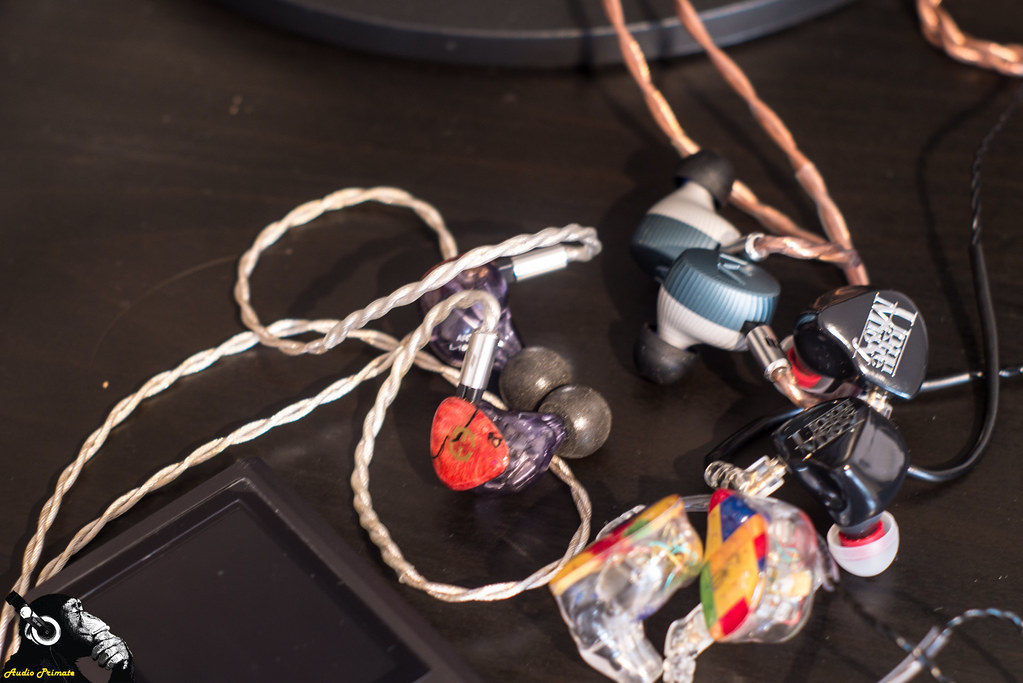
Unique Melody Miracle v2
Why – Strawberries less stage depth on the Unique Melody miracle. Sound is bigger and more forward but with less natural staging. Bass is a bit thicker on the Miracle. Mids are forward on the Unique Melody. There is a lot more depth and width in the Arthur. The forwardness of the signature makes the Miracle v2 less realistic sounding. Both have excellent technical capability, but the Arthur is noticeably superior. It should be for nearly 4x the price and more than double the drivers.Listening to Carlos Heredia – Chachipen-Bulerias. The Arthur’s dimensionality and resolution is stunning. The acoustic guitar, percussive claps and singing are like being there. Tonally, the Miracle v2 is a pretty good match on this track. The whole sound is feels louder, which may be due to a boost in the mids on the Miracle v2 or recession in the mids on the Arthur. The soundstage height is impressive on the v2, but the Arthur wins easily on depth and width. Both are truly excellent headphones that have a very natural timbre.
On Led Zeppelin – D’yer Mak’er bass and mids are smoother and bigger on the Melody v2. As observed on previous tracks the sound is more forward with less stage depth and width at the same SPL. Drums have a bit more hollow sound on the Melody v2. The Arthur has a more distant presentation, with less relative weight, increasing the volume 3 clicks, which is probably a little over a decibel, brings the mids to the same weight as the Miracle v2. Unsurprisingly, this also makes the Arthur win even more on dynamics and stage. I think people will listen to the Arthur a little louder than other headphones, but when they do, boy does it step up. My normal listening level is about 78dB. I think I’d listen to the Arthur at 80dB to bring those mids forward a little bit.
The Arthur soundstage is huge on Amber Rubarth – Tundra. Hot damn.

On Yosi Horikawa – Bubbles (thanks to Warren P. Chi for the recommendation), the sound is much more delicate and nuanced on the Arthur. The Melody v2 is in your face with nuances not quite having the same delicate delineation. The Arthur is more refined. The Melody v2 is thicker sounding, but thick only in relative terms to the Arthur. The Melody v2 is not a thick sounding headphone.
Victor: On sound quality, the Arthur. It is more refined has a huge soundstage and a natural timbre and resolution. The Miracle V2 does firmly show what kind of value can be had for around $1000.
UERR
After listening to the Miracle v2, I switched to the UERR for Yosi Horikawa – Bubbles and the mids sound more like the Arthur. As the UERR is meant to be a reference headphone, I’ll take this to mean that the Arthur mids are more neutral. The UERR is a bit forward of the Arthur, so a little bit of recession in the mids is likely there. The stage is a bit wider and deeper on the Arthur. Height advantage is tight. Let’s check the Pixies – Where is My Mind for ye’ olde height difference.Height advantage goes to the UERR for the female backing vocal on Where is My Mind. However, the tone is more natural and musical sounding on the Arthur. The UERR doesn’t make me think of live music, it lacks the lush sonic tones and richer pallet. Those mids are a little recessed on the Arthur, though, so I do believe I’m not the only one hitting volume a little. All the mids details like the little male vocals—the quiet where is my mind questioning in the back drop, are still there but quieter. I’d guess the vocal range of mids is one or two dB down from neutral. Over time your ears adjust a little bit, but the drop is definitely there.
On Strawberries by Why? Yoni Wolf’s vocals are silky smooth and emotive. The bass has great kick and the chimes and piano absolutely sparkle and splay on the Arthur. The instrument separation and bass character are phenomenal. There is definitely less width to the stage on the UERR. Resolution is good on both, but hand claps have a little bit of a thin sound to them with the UERR, like the decay has been truncated a bit. The sound is a bit thicker and firmer on the Arthur.
On D’yer Mak’er (Led Zeppelin) the sound stage is much more congested sounding on the UERR. There is less separation between instruments and a more immediate sound. It sounds louder than the Arthur, but the soundstage difference is still apparent. This louder character has me questioning whether my volume matching was perfect, but I’m not sure I can completely eliminate the potential measurement error.
Victor: Conclusions are similar to the Miracle V2. The sound quality edge goes to Arthur, but the UERR are an unquestionable value.
Noble Kaiser Encore
I listened to some of the same tracks, but included a couple curve balls when doing comparisons with the Kaiser Encore. I also used the Encore with the Effect Audio Ares II+ aftermarket cable instead of stock. This means that the total cost for the Kaiser Encore setup is about $2070 instead of $1850 (£1699). First I loaded up some Daft Punk.On Too Long, there is some delicate high trill electronic effects and subtle static. The Arthur does a better job resolving these special effects. Similarly, after the 7 minute mark in the song—long indeed—there is some grooving bass. The Kaiser Encore has longer decay on the bass with more power. The Arthur is more compact in its bass notes. Sound preference on this bass expression will vary from person to person, but I imagine that more folks will prefer the Encores expression here. Arthur was airier for the whole track.
On Why – Strawberries the Noble has that same strong bass expression we heard on Too Long with longer decay and more presence than the Arthur. The Kaiser Encore also has smoother mids that are more forward. As noted in the UERR and Miracle V2 comparisons, the Arthur has some recession in the mids. However, treble-centric instruments like violins sound better on the Arthur. Violins are smoother and more enjoyable on this track with the Arthur. This track has some prickly violin, and that is still there on both, but the Arthur is a bit nicer.
Bubbles is a fantastic track. The Encore presents the sound in a more lush manner, whilst the Arthur is more precise, neither goes overboard on either side. The Encore is never woolly, and the Arthur is never surgical and sterile, both have wonderful musicality. The Arthur gets the resolution edge here, but the Encore has the edge on soul.
I mentioned earlier that I listened for 4 hours straight to jazz with the Arthur, which is something I just don’t do. Silly Samba by Clark Terry is a standout track on a standout 30thAnniversary Compilation from Chesky. The Arthur excels technically on this track with more air and faster bass. However, the Encore sounds a bit more organic. It has lusher horns, whilst the Arthur sounds a bit drier.
The Encore’s extra weight in the mids gives extra emotional force to tracks. I find much of the emotion in tracks lies in the mids, so the Encore’s lush brushstrokes really paint a beautiful picture.
Like on other songs, Encore is more aggressive and forceful on Rage Against the Machine – Take the Power Back. Drums have more kick and push more air. The mids have fuller body and lusher dynamics. The Arthur is precise with calculated crunchy guitars and sharp focus. Because of the recession in Arthur’s mids, the mids on the Encore sound clearer.
Verdict: This is very tight. The Arthur has greater technical capabilities (bigger soundstage, better detail resolution), but it costs almost double what the Encore does. It has a bigger soundstage and better resolution. However, it lacks the emotional weight that the Encore carries and the raw power in the lows and low mids. The Arthur can rock, but not like the Encore rocks. On tracks that require complex spatial resolution and precise instrumentation, the Arthur wins, but this isn’t a huge amount of my more rock-oriented library. Signature wise, I think I narrowly prefer the Encore, but it wouldn’t be on all tracks and I miss the soundstage and perfect clarity and resolution of the Arthur already. Winner, by a hair: Noble Kaiser Encore for better value and a sound signature that fits more of my music.
Specifications
Much like with the Noble Kaiser Encore, Empire Ears and Effect Audio aren’t providing a whole lot of information. There is no frequency response curve, no data on sensitivity, and a throwaway 20hz to 20Khz frequency response range given. I tested the frequency response with tones and I can hear 10hz and 23Khz with the Arthur. It is not lacking in any way in extension on either end of the spectrum.| Specifications | |
| Price | $3799 |
| Drivers | 14 drivers per ear (2 low, 6 mid, 6 high) |
| Crossover | 8 way passive crossover |
| Frequency Response | 20hz to 20Khz |
| Noise Isolation | 28dB ± 2dB |
Conclusions
The Effect Audio Arthur is a special piece of kit. I found it competed with the full-size open ear HiFiMAN HE-1000 V2, which is quite a feat. I haven’t heard a more technically competent IEM than the Arthur. It’s soundstage is spectacular with jaw-dropping width and depth. It has precise imaging and exceptional resolution. The accompanying Excalibur cable is a work of art well-executed by Effect Audio and premium in every way. The Silver-Gold Litz wire oozes luxury with glittering facade, and presence when it coils coils round the top of your ear akin to the lightness of a silken. The Arthur is a statement piece in every way. The Excalibur cable makes you feel like rich person, even if you are of more modest means.Whether the Arthur is your ideal headphone likely depends more on the type of music you listen to. If you are into Jazz and Classical, I think the Arthur will be nearly perfect. If you listen to more rock, like myself, you may find that you want a bit more emotional investment in the mids and lusher fuller bass character like that found on the Noble Kaiser Encore. I haven’t heard better for soundstage in any IEM than what the Arthur accomplishes. It is truly astounding.
][/color])











